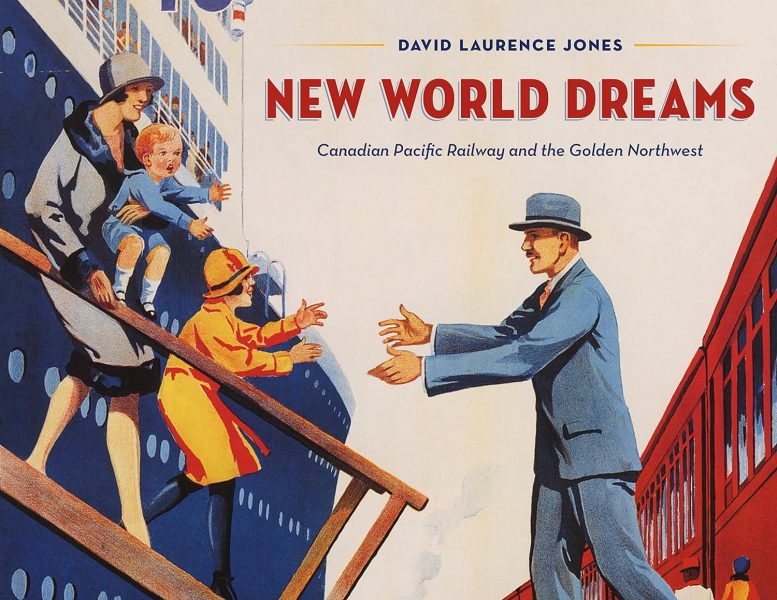
New World Dreams: Canadian Pacific Railway and the Golden Northwest
Review By Christopher Herbert
August 20, 2024
BC Studies no. 222 Summer 2024 | p. 167-168
As any Canadian schoolchild knows, the Canadian Pacific Railway (CPR) was borne out of the desire to unify the newly created country of Canada with, as Gordon Lightfoot memorably phrased it, “an iron road runnin’ from the sea to the sea.” In the Canadian psyche, the CPR occupies a position surpassed only by that of the Hudson’s Bay Company. And yet, in New World Dreams, David Jones manages to delve into an oft-overlooked aspect of the CPR’s role in the building of modern Canada: the CPR’s efforts in promoting the settlement of the Prairies.
Covering a period from the CPR’s founding in the 1880s to the end of land sales by the CPR in 1964, Jones shows how financial self-interest and nationalist sentiment drove the CPR to invest huge sums of money to promote the immigration of a relatively diverse population onto the Prairies. New World Dreams is divided into thirteen chapters, organized essentially chronologically. The bulk of the book, the first nine chapters, focuses on the period before the First World War. The remaining four chapters then speed quickly through the War, the Twenties, Great Depression, World War II, and the post-war period.
New World Dreams is a coffee table book, filled with page after page of eye-catching images and photographs. However, unlike most coffee table books, New World Dreams is also very text heavy, reflecting the author’s deep familiarity with the topic and extensive research. As a result, the book has far more to offer than just pretty pictures.
One would think that a history of the CPR by a former rail employee would be triumphalist, but while Jones emphasizes the CPR’s achievements, he is also more than willing to point out the human and environmental costs of the CPR’s expansionistic vison. There are limits, however. Jones’ focus is on the effort to settle people on the Prairies, and readers expecting a more traditional narrative of the construction of the CPR and the experience of the builders will be disappointed. Indeed, the use of different ethnic and racial groups to construct the railway receives only passing mention.
One of the most interesting parts of New World Dreams is the tension that emerges throughout the work between shifting governmental and popular attitudes towards various groups of immigrants and the consistently more liberal approach of the CPR. Fueled by self-interest (after all, the CPR was trying to sell its land and increase traffic on its railway), the CPR consistently supported the immigration of groups that were considered less desirable, especially Eastern Europeans. In contrast, public opinion and government policy vacillated before giving way to a rising tide of ethnocentrism in the 20th century. Further complicating this debate between conflicting visions of a diverse or homogenous prairie population were deep-seated concerns about the so-called “ideal immigrants” from Britain who, many Canadians suspected, were actually the dregs of British society and unsuited to the hard labor of farm life.
The other interesting thread that develops throughout New World Dreams is the development of the CPR’s recruitment efforts. I expected to read a book about pamphlets, flyers, and other sorts of propaganda. New World Dreams has that, but it also has a fascinating history of model farms, experimental stations, traveling exhibits, clandestine recruitment agents, and more. Indeed, by the end of the work, it almost seems like trains have become an afterthought to the CPR’s steamships and, eventually, airline, that were used to move immigrants and refugees to the Prairies. Jones reveals the extraordinary complexity and cost of the CPR’s efforts to encourage settlement on the Prairies.
There is more here, which is not surprising given the work’s 403 pages, but suffice it to say that individuals with an interest in the CPR, immigration during the late 19th and early 20th centuries, or prairie history will find this an informative and attractive addition to their coffee table.
Publication Information
Jones, David Laurence. New World Dreams: Canadian Pacific Railway and the Golden Northwest. Victoria: Heritage House Publishing, 2023. 448 pp. $49.95 paper.
